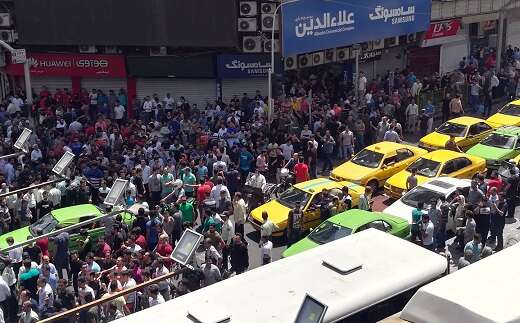Thousands of Iranians angered over their country's failing economy took to the streets to protest for the third consecutive day Monday, clashing with security forces in what appears to be the biggest domestic political challenge to Iran's leaders since the Green movement was crushed by the Revolutionary Guards in 2009.
Gaining momentum by the day, the protests signal the Iranian people's widespread unease in the wake of U.S. President Donald Trump's decision to withdraw from the 2015 nuclear accord, and their fear of what the future will bring as new U.S. sanctions loom.
It was not immediately clear who was leading the protests. Iran's Fars, ISNA and Tasnim news agencies described the demonstrations in Tehran and elsewhere across the country as having erupted after the Iranian rial plunged to 90,000 to the U.S. dollar despite government attempts to control the exchange rate.
On Sunday, Interior Minister Rahmani Fazli Abdolrahman warned protesters that their actions will have consequences, saying, "Those who damage public property, disrupt order and break the law must be responsible for their behavior and pay the price."
But the demonstrators seemed undeterred.
Students near Tehran University chanted "We don't want the ayatollahs," "Death to the dictator" and "Death to Khamenei," referring to Supreme Leader Ayatollah Ali Khamenei.
Videos posted on social media showed protesters chanting "Death to Palestine," "No to Gaza, no to Lebanon" and "Leave Syria and think of us," indicating widespread anger at the Iranian regime for spending billions of dollars on proxy wars in the Middle East and supporting terrorist groups such as Hezbollah in Lebanon and the Houthis in Yemen instead of investing in the struggling economy at home.

Other videos showed protesters across Iran taking down banners depicting Khamenei. Such chants and acts of dissent are unprecedented in Iran, where the supreme leader holds ultimate authority and criticizing him is taboo.
Iranian media said dozens of people had been arrested in demonstrations across the country, but the exact number was unclear.
'Resistance economy'
In an attempt to shore up the economy, Iranian authorities announced Monday that they were banning imports of more than 1,300 products.
Industries and Trade Minister Mohammad Shariatmadari slapped the import ban on 1,339 goods that could instead be produced in the country. Prohibited imports include home appliances, textile products, footwear, leather products, furniture, health care products and some machinery.
The order suggests that the U.S. sanctions threat is pushing the Iranian leadership back towards running a "resistance economy" designed to conserve foreign exchange reserves and become as self-sufficient as possible in many products.
Iran eased its "resistance economy" policy after many international sanctions were lifted in January 2016 under the nuclear deal, when President Hassan Rouhani announced plans to boost Iran's foreign trade and give foreign companies a bigger role in its economy.
With Iran now aiming to close its markets to many foreign products and the government intervening to support locally owned companies, those goals look more distant.
"In the coming months we will see much more intervention in the economy by the government, a centrally imposed style of management by dictate," said Mehrdad Emadi, an Iranian economist who heads energy risk analysis at London's Betamatrix consultancy.
One result is likely to be a shift of influence over Iran's non-oil foreign trade from the private sector, along with a strong presence by the government's Revolutionary Guards, to near-complete dominance by the Guards, he said.
Emadi and other Iranian economists said Iran had imposed import bans during the previous sanctions era before 2016, with only limited success.
The government is justifying its latest clampdown on imports by citing economic security.
The Tehran Times quoted Mohammad Reza Pourebrahimi, head of the parliamentary economic committee, as saying the ban would prevent an outflow of $10 billion in foreign currency.
The International Monetary Fund estimated in March that the Iranian government held $112 billion in foreign assets and reserves and that Iran was running a current account surplus. These figures suggest Iran might withstand the sanctions without an external payments crisis.
At the end of last year, similar economic protests rattled Iran and spread to about 75 cities and towns, becoming the largest demonstrations in the country since the 2009 disputed presidential election. At least 25 people were killed and nearly 5,000 others were arrested in the protests in late December and early January.



